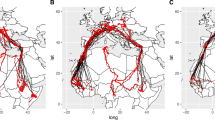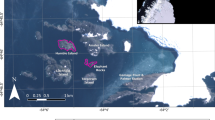Abstract
The Kyrgyz population of the bar-headed goose Anser indicus has declined dramatically during the past decades. Human persecution during migration and habitat loss at stopover and wintering sites are commonly regarded as most serious threats. However, little is known about seasonal movements, migration routes, and wintering sites of the bar-headed geese from Kyrgyzstan, which represent the westernmost geographical population of the species. As part of a conservation project, which also included reinforcement of the wild population by the release of hand-reared juveniles, in late summer of 1998, five bar-headed geese, three wild adults and two hand-reared goslings, were fitted with sun-powered satellite transmitters in order to track their movements from Lake Son Kul and Lake Chatyr Kul in Kyrgyzstan. The five individuals contributed very unevenly to the more than 5,000 signals in total that were received from the French ARGOS system: one failed after 8 weeks, while another one was tracked for more than 2 years. The four geese contributing to this study followed three completely different migration routes leading to their wintering areas in Pakistan, India and Uzbekistan, while stopover areas were situated in southern Tajikistan and in western Tibet. Both in autumn and spring the adult birds migrated distances of 1,280–1,550 km in two steps, with stopover periods of 32–46 days (autumn) and 16–23 days (spring). Flight speeds of up to 680 km per actual migration day were recorded regularly, even during crossings of very high summits. A hand-reared juvenile flew non-stop for 790 km to southern Uzbekistan and even visited southernmost Turkmenistan, where the species is very rarely seen. The timing of migration varied considerably between individuals but also for the same individual between years. We compare our tracking results with previous findings (field observations, ring recoveries, and satellite tracking results) and discuss them with respect to migration over high-mountain habitats and a general migration strategy of the species.



Similar content being viewed by others
References
Abdusalyamov IA (1971) The Fauna of the Tajik SSR. I. Birds (in Russian). Dushanbe
Ali S, Ripley SD (1987) Handbook of the birds of India and Pakistan. Oxford University Press, New Delhi
ARGOS (2007) User Manual, Service Argos. Toulouse. http://www.argossystem.org/documents/userarea/argos_manual_en.pdfCLS/
Berthold P (2007) Vogelzug. Eine aktuelle Gesamtübersicht. Wissenschaftliche Buchgesellschaft, Darmstadt
BirdLife International (2000) Threatened birds of the world. Lynx Edicions and BirdLife International, Barcelona and Cambridge
Bishop MA, Song Y, Canjue Z, Gu B (1997) Status and distribution of bar-headed geese Anser indicus wintering in south-central Tibet. Wildfowl 48:118–126
Black JM, Owen M (1989) Agonistic behaviour in barnacle goose flocks: assessment, investment and reproductive success. Anim Behav 37:199–209
Black CP, Tenny SM (1980) Oxygen transport during progressive hypoxia in high-altitude and sea-level waterfowl. Respir Physiol 39:217–239
Borodin AM, Bannikov AG, Sokolov WE (eds) (1985) Red data book of the U.S.S.R. (Krasnaya Kniga SSSR), vol 1 (Animals). Nauka, Moscow
Borshonov BB (1978) On flights of bar-headed geese to Taimyr peninsula (in Russian). Novosib Naucnotech Bull NIIS 15:44–46
Braunitzer G, Hiebl I (1988) Molekulare Aspekte der Höhenatmung von Vögeln. Hämoglobine der Streifengans (Anser indicus), der Andengans (Chloephaga melanoptera) und des Sperbergeiers (Gyps rueppellii). Naturwissenschaften 75:280–287
Butler PJ, Bishop CM (2000) Flight. In: Whittow GC (ed) Avian physiology. Academic Press, San Diego
Choudhury A (1997) The bar-headed goose in north-eastern India and Bhutan. J Ecol Soc 10:17–19
Collar NJ, Andrew P (1988) Birds to watch—the ICBP world check-list of threatened birds. ICBP Technical Publication no. 8, Cambridge
Collar NJ, Crosby MJ, Stattersfield AJ (1994) Birds to watch 2—the world list of threatened birds. Birdlife International, Birdlife Conservation Series no. 4, Cambridge
Danilov-Danilian VI (ed) (2001) Red data book of the Russian federation: animals. Nauka, Moscow
Del Hoyo J, Elliott A, Sargatal J (1992) Handbook of the birds of the world, vol.1. Lynx Edicions, Barcelona
Dolnik VR (1990) Bird migration across arid and mountainous regions of middle Asia and Kazakhstan. In: Gwinner E (ed) Bird migration: the physiology and ecophysiology. Springer, New York
Dunning JB (1993) CRC handbook of avian body masses. CRC Press, London, Tokyo
Eichhorn G, Drent RH, Stahl J, Leito A, Alerstam T (2009) Skipping the Baltic: the emergence of a dichotomy of alternative spring migration strategies in Russian barnacle geese. J Anim Ecol 78:63–72. doi:https://doi.org/10.1111/j.1365-2656.2008.01485
Elphick J (1995) Collins atlas of bird migration. Harper & Collins, London
Gudmundsson GA, Benvenuti S, Alerstam T, Papi F, Lilliendahl K, Akesson S (1995) Examining the limits of flight and orientation performance: satellite tracking of brent geese migrating across the Greenland ice-cap. Proc R Soc Lond 261:73–79
Hays G, Akesson S, Godley B, Luschi P, Santridrian P (2001) The implications of location accuracy for the interpretation of satellite-tracking data. Anim Behav 61:1035–1040
Javed S, Takekawa JY, Douglas DC, Rahmani AR, Kanai Y, Nagendran M, Choudhury BC, Sharma S (2000) Tracking the spring migration of a bar-headed goose (Anser indicus) across the Himalaya with satellite telemetry. Glob Environ Res 4:195–206
Kaatz M (2004) Der Zug des Weißstorchs Ciconia ciconia auf der europäischen Ostroute über den Nahen Osten nach Afrika. Ph.D. thesis, Martin-Luther-University, Halle-Wittenberg, Germany, p 163
Kear J (2005) Bird families of the world. Ducks, geese and swans, vol. 1. University Press, Oxford
Knystaustas A (1993) Birds of Russia. Harper Collins, London
Kydyraliev AK (1967) Bar-headed geese (Anser indicus) in the Tian-Shan mountains (in Russian). Ornitologiya 8:245–253
Kydyraliev AK (1973) Waterfowl of the central Tian-Shan (in Russian). Frunse
Kydyraliev AK, Abdusalyamov IA (1979) Migrations of bar-headed goose. In: Ilyichev WD (ed) Migrations of birds of eastern Europe and Northern Asia. Nauka, Moscow
Lorentsen SH, Oien JI, Aarvak T (1998) Migration of Fennoscandian lesser white-fronted geese Anser erythropus mapped by satellite telemetry. Biol Conserv 84:47–52
Lu J (1997) Distribution of bar-headed goose in China. Ecol Soc 10:8–9
McClure HE (1998) Migration and survival of the birds of Asia. White Lotus Press, Bangkok
McKinnon J, Phillips K (2000) A field guide to the birds of China. Oxford University Press, Oxford
Melnikov U (1997) Rare geese species in the Baikal area: distribution and occurrence (in Russian). Russ J Ornithol Express Issue 21:14–19
Mineev EY, Mineev YN (2000) Bar-headed geese Eulabeia indica in the Bolshesemelskaya tundra (in Russian). Russ J Ornithol Express Issue 113:22
Ming M, Dai C (1999) Breeding ecology of bar-headed goose in Tianshan, Xinjiang. Casarca 5:177–181
Miyabayashi Y, Mundkur T (1999) Atlas of key sites for Anatidae in the east Asian flyway. Tokyo, Wetlands International–Japan and Kuala Lumpur, Wetlands International–Asia Pacific
Newton I (2008) The migration ecology of birds. Migration systems and population limitation. Academic Press, London, pp 697–822
Perennou CT, Mundkur T, Scott DA, Follestad AN, Kvenild L (1994) The Asian waterfowl census 1987–1991: distribution and status of Asian waterfowl. Asian Waterfowl Bureau, publication no. 86, Kuala Lumpur
Prevett JP, McInnes CD (1980) Family and other social groups in snow geese. Wildl Monogr 71:1–46
Roberts TI (1991) The birds of Pakistan, volume 1. Regional studies and non-passeriformes. Oxford University Press, Oxford
Rutschke E (1997) Wildgänse. Lebensweise-Schutz-Nutzung. Paul Parey, Berlin
Saunders DK, Fedde MR (1991) Physical conditioning: effect on the myoglobin concentration in skeletal and cardiac muscle of bar-headed geese. Comp Biochem Physiol A Comp Physiol 100:349–352
Selesnev VF (1976) On the bar-headed goose in Tajikistan (in Russian). In: Gladkov NA (ed) Rare, extinct and less investigated birds of the U.S.S.R. Nauka, Ryasan
Swan LW (1970) Goose of the Himalayas. Nat Hist 79:68–74
Syroechkovskyi EE, Rogacheva EW (1995) Red data book of Krasnoyarsk county (in Russian). Krasnoyarsk
The U.S. Geological Survey (USGS) (2006) Bar-headed goose migration over the Himalaya Cordellera 2005. Western Ecological Research Center, Sacramento, USA. http://www.werc.usgs.gov/sattrack/project2005.html
Yakovlev AP (1997) Current population status of the bar-headed Goose (Anser indicus) in Kirgizia and its preservation. Casarca 3:260–270
Zhang J, Hua Z, Tame RH, Lu G, Zhang R, Gu X (1996) The crystal structure of a high oxygen affinity species of haemoglobin (bar-headed goose haemoglobin in the oxy form). J Mol Biol 255:484–493
Acknowledgments
Thanks to the kind support of the German Max-Planck-Society, Vogelwarte Radolfzell, satellite transmitters became available to conduct this study. We are particularly thankful to Dr. E. Kreuzberg-Muchina, Dushanbe, Dr. V. Toropova, Bishkek, and Prof. A. Kovshar, Almaty, who provided unpublished information on current phenomena in Central Asian waterfowl and submitted additional data on earlier ring recoveries. U. Querner, Radolfzell, continuously assisted the data transfer and commented on the findings with his great experience. Owing to the kind assistance of Dr. J. Shergalin, Tallinn, Russian publications became accessible. A. Bräunlich, Berlin, and A. Globig, Tremt, provided valuable comments on earlier versions of this paper. For catching and marking wild bar-headed geese, as well as for any activities inside areas protected by nature conservation law, official permissions were granted by the state nature conservation authorities of Kyrgyzstan. Many thanks as well to the two anonymous reviewers, who provided invaluable advice for improving earlier versions of the manuscript.
Author information
Authors and Affiliations
Corresponding author
Additional information
Communicated by F. Bairlein.
Rights and permissions
About this article
Cite this article
Köppen, U., Yakovlev, A.P., Barth, R. et al. Seasonal migrations of four individual bar-headed geese Anser indicus from Kyrgyzstan followed by satellite telemetry. J Ornithol 151, 703–712 (2010). https://doi.org/10.1007/s10336-010-0492-1
Received:
Revised:
Accepted:
Published:
Issue Date:
DOI: https://doi.org/10.1007/s10336-010-0492-1




